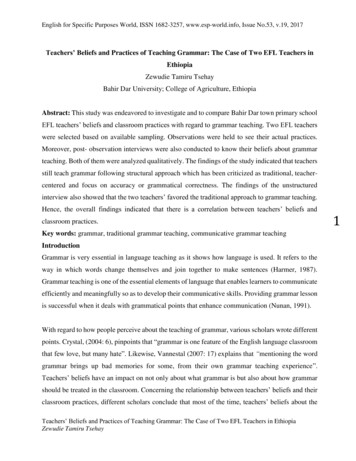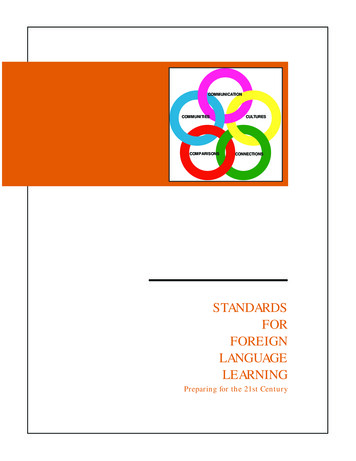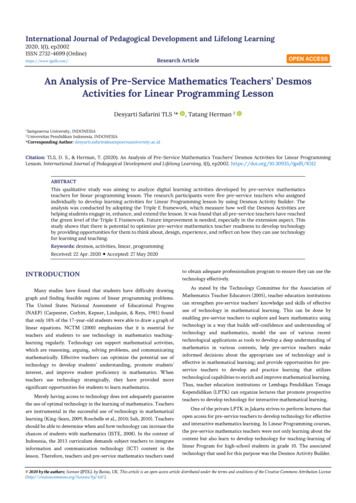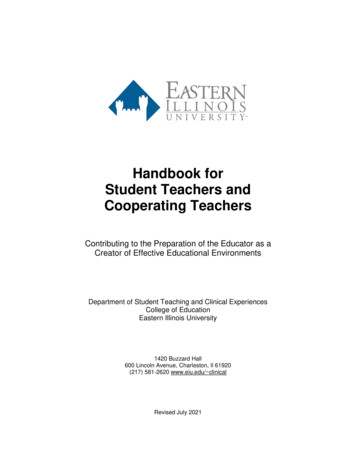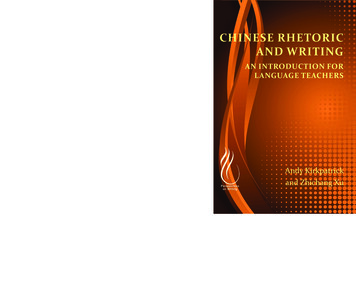
Transcription
CHINESE RHETORICAND WRITINGAN INTRODUCTION FORLANGUAGE TEACHERSAndy Kirkpatrickand Zhichang Xu
CHINESE RHETORIC ANDWRITING: AN INTRODUCTIONFOR LANGUAGE TEACHERS
PERSPECTIVES ON WRITINGSeries Editor, Susan H. McLeodThe Perspectives on Writing series addresses writing studies in a broad sense.Consistent with the wide ranging approaches characteristic of teaching andscholarship in writing across the curriculum, the series presents works that takedivergent perspectives on working as a writer, teaching writing, administeringwriting programs, and studying writing in its various forms.INTERNATIONAL EXCHANGES ON THE STUDY OF WRITINGSeries Editors, Terry Myers Zawacki, Magnus Gustafsson, and Joan MullinThe International Exchanges on the Study of Writing Series publishes booklength manuscripts that address worldwide perspectives on writing, writers,teaching with writing, and scholarly writing practices, specifically those thatdraw on scholarship across national and disciplinary borders to challenge parochial understandings of all of the above. The series aims to examine writingactivities in 21st-century contexts, particularly how they are informed by globalization, national identity, social networking, and increased cross-culturalcommunication and awareness. As such, the series strives to investigate howboth the local and the international inform writing research and the facilitation of writing development.The WAC Clearinghouse and Parlor Press are collaborating so that these bookswill be widely available through free digital distribution and low-cost printeditions. The publishers and the Series editor are teachers and researchers ofwriting, committed to the principle that knowledge should freely circulate.We see the opportunities that new technologies have for further democratizingknowledge. And we see that to share the power of writing is to share the meansfor all to articulate their needs, interest, and learning into the great experimentof literacy.Other Books in the Perspectives on Writing SeriesCharles Bazerman and David R. Russell (Eds.), Writing Selves/Writing Societies(2003)Gerald P. Delahunty and James Garvey, The English Language: From Sound toSense (2009)Charles Bazerman, Adair Bonini, and Débora Figueiredo (Eds.), Genre in aChanging World (2009)David Franke, Alex Reid, and Anthony Di Renzo (Eds.), Design Discourse:Composing and Revising Programs in Professional and Technical Writing (2010)
CHINESE RHETORIC ANDWRITING: AN INTRODUCTIONFOR LANGUAGE TEACHERSAndy Kirkpatrick and Zhichang XuThe WAC Clearinghousewac.colostate.eduFort Collins, ColoradoParlor Presswww.parlorpress.comAnderson, South Carolina
The WAC Clearinghouse, Fort Collins, Colorado 80523Parlor Press, 3015 Brackenberry Drive, Anderson, South Carolina 29621 2012 by Andy Kirkpatrick and Zhichang Xu. This work is licensed under a Creative CommonsAttribution-Noncommercial-No Derivative Works 3.0 United States License.ISBN 978-0-97270-239-3 (pdf ) 978-0-97270-230-0 (epub) 978-1-60235-300-8(pbk.)DOI 10.37514/PER-B.2012.2393Produced in the United States of AmericaLibrary of Congress Cataloging-in-Publication DataChinese rhetoric and writing : an introduction for language teachers / Andy Kirkpatrick andZhichang Xu.p. cm. -- (Perspectives on writing)Includes bibliographical references.ISBN 978-1-60235-300-8 (pbk. : alk. paper) -- ISBN 978-1-60235-301-5 (alk. paper) -- ISBN978-0-97270-239-3 (pdf ) -- ISBN 978-0-97270-230-0 (epub)1. Chinese language--Rhetoric--Study and teaching. 2. Report writing--Study and teaching-China. I. Xu, Zhichang. II. Title.PL1129.E5K57 2012495.1’82421--dc232012005609Copyeditor: Don DonahueDesigner: Mike PalmquistPerspectives on Writing Series Editor: Susan H. McLeodInternational Exchanges Series Editors: Terry Myers Zawacki, Magnus Gustafsson, and JoanMullinThe WAC Clearinghouse supports teachers of writing across the disciplines. Hosted byColorado State University, it brings together scholarly journals and book series as well asresources for teachers who use writing in their courses. This book is available in digital formatfor free download at wac.colostate.edu.Parlor Press, LLC is an independent publisher of scholarly and trade titles in print andmultimedia formats. This book is available in paperback, cloth, and eBook formats from ParlorPress at www.parlorpress.com. For submission information or to find out about Parlor Presspublications, write to Parlor Press, 3015 Brackenberry Drive, Anderson, South Carolina 29621,or e-mail editor@parlorpress.com.
CONTENTSIntroduction 31 Rhetoric in Ancient China 132 The Literary Background And Rhetorical Styles 313 The Rules of Writing in Medieval China and Europe 514 The Ba Gu Wen(八股文) 755 Shuyuan and Chinese Writing Training and Practice 936 Principles of Sequencing and Rhetorical Organisation: Words,Sentences and Complex Clauses 1077 Principles of Sequencing and Rhetorical Organisation: Discourseand Text 1258 The End of Empire and External Influences 1439 Party Politics, the Cultural Revolution and Charter 08 16310 A Review of Contemporary Chinese University Writing(Course) Books 189Conclusion 203Works Cited 207Notes 221v
CHINESE RHETORIC ANDWRITING: AN INTRODUCTIONFOR LANGUAGE TEACHERS
INTRODUCTIONThe primary aim of this book is to give teachers of writing, especially thoseinvolved in the teaching of English academic writing to Chinese students, anintroduction to key stages in the development of Chinese rhetoric. The bookwill make Western readers familiar with Chinese rhetorical styles and Chinesescholarship on Chinese rhetoric.Chinese rhetoric is a wide-ranging field with a history of several thousandyears. This book is concerned with what might be loosely termed non-fictionor “academic” writing and the writing of essays. It therefore does not deal inany depth with the Chinese poetic tradition. While the focus is on writing,principles of persuasion in Chinese oral texts will also be considered.Why is such a book necessary? For some forty years, it has been customaryto argue that Chinese students’ academic writing in English has been influencedby traditional Chinese writing styles. Many scholars, both Chinese and Western,have long argued that Chinese rhetorical norms and traditions are somehowunique to Chinese and that these, when transferred into academic writing inEnglish are a source of negative interference (cf. Kaplan; Jia and Cheng; J.Chen). The underlying assumption is that the English writing of these studentsis, in some way, inappropriate to academic writing in English. The view is thatChinese students bring with them culturally nuanced rhetorical baggage that isuniquely Chinese and hard to eradicate.In this book we shall argue that these views stem from an essentiallymonolingual and Anglo-centric view of writing and that, given the exponentialincrease in the international learning and use of English, there needs to be aradical reassessment of what English is in today’s world. It is no more than atruism to point out that there are many more speakers of English who havelearned it as an additional language and use it, either as a new variety of English,such as Indian English, or as a lingua franca, than there are native speakers of it.Kingsley Bolton has estimated that there are some 800 million users of Englishin Asia alone. In China, it has been estimated that there are currently more than350 million people who are learning English (Xu, Chinese English). This means3
Introductionthat there are more speakers of English in China than the total population of theUnited States. If we also consider the number of English speakers in Europe andother parts of the world–bearing in mind, for example, that when people whobelong to the so-called BRIC group, which comprises Brazil, Russia, India and,China normally communicate through English—it becomes clear that Englishis now a language far more used by multilinguals than by native speakers.To date, the native speaker and Anglo-American rhetorical styles haveremained the benchmarks against which other English users are measured,although many scholars have argued for some years that this needs to change.John Swales suggested that it was time “to reflect soberly on Anglophonegate-keeping practices” (380) and scholars such as Ammon have called for anew culture of communication which respects the non-native speaker (114).Canagarajah (A Geopolitics of Academic Writing) has pointed out that, in this ageof globalisation, we need to be able to accommodate and respect people who aremoving between different cultural and rhetorical traditions. Likewise we shallhere argue that, in today’s globalising and multilingual world “we need to besensitive to rhetorical traditions and practices in different linguistic and ethniccommunities” (You, Writing, 178).We shall describe the Chinese rhetorical tradition in order to illustrate itsrich complexity and show that Chinese writing styles are dynamic and changefor the same types of reasons and in the same types of ways as writing stylesin other great literate cultures. In particular, we will argue that the sociopolitical context is a main driver of change in Chinese writing styles. To argue,therefore, that Chinese students bring with them culturally determined andvirtually ineradicable rhetorical traditions to their English writing is to overlookthe contextual influences of writing styles and the rich and complex Chineserhetorical tradition. It also overlooks the value of different rhetorical traditions.The aim of the teacher of writing should not be to gut the English of theChinese writer of local cultural and rhetorical influences, but to look to see howthese can be combined with other rhetorical “norms” to form innovative andeffective texts. This will require the writing teacher to have some knowledgeof Chinese rhetorical practices. This book will provide writing teachers witha reference to the ways Chinese writing styles have developed over time and aclear understanding of how writing styles change and develop.An example may help illustrate this point. Chapter 3 includes a summaryof the Wen Ze or Rules of Writing. This was written by Chen Kui in 1170. TheWen Ze is an important text, being commonly referred to by Chinese scholars asChina’s first systematic account of rhetoric (Zheng; Zong and Li; Zhou).The rhetorical principles that The Rules of Writing promulgates includethe importance of using clear and straightforward language, the primacy of4
Chinese Rhetoric and Writingmeaning over form, and ways of arranging argument. These principles were,in large part, determined by the needs of the time (Kirkpatrick, “China’sFirst Systematic Account”). The Rules of Writing was written at a time of greatchange in China. Two changes were of particular importance. The first was thedevelopment of printing (Cherniack). This made texts much more accessibleand affordable than they had been before. The second change was that the Songdynasty sought to increase dramatically the number of men entering the civilservice through merit, as opposed to privilege (Chaffee). The role of the civilservice exams in ensuring only men of merit entered the civil service increasedsignificantly. We have argued that The Rules of Writing was written as a guidefor men who wanted to enter a career in the civil service and who needed topass the strict series of civil service exams in order to do so. As such, it can becompared with contemporary “Anglo” texts on rhetoric that aim to provideuniversity students with advice on the correct way of writing academic texts.This book also aims to encourage debate about the “primacy” of AngloAmerican rhetoric. While it is indisputable that English is the primary languageof research and publication and that this English is a specialised variety based onAnglo-American rhetorical principles, this encourages a one-way flow of ideas.We need to create an environment in which the ideas of others can flow throughto the Anglo-American world. We need to debate the proposition that ideas andresearch which do not conform to Anglo-American rhetorical principles mightbe presented and published in varieties of English (cf. Canagarajah; Swales). Asthe world of education becomes increasingly international, the more we knowabout the rhetorical traditions of different cultures the better. And, of course,as China becomes increasingly powerful and influential, the world needs tounderstand Chinese culture; and we cannot understand China “without alsounderstanding what it says, how it says things, how its current discourses areconnected with its past and those of other cultures” (Shi-Xu 224–45).The book also aims to make a contribution to the debate over the linkbetween language, thought and culture. Chinese has commonly been seen asa prime exemplar of the Sapir-Whorf hypothesis, as scholars (cf. Graham, TheDisputers of the Dao) have argued that the Chinese language determines Chineseways of thinking and seeing the world. This view has recently been challenged(Wardy), and the book will provide further evidence that it is the socio-politicalcontext, rather than underlying thought patterns determined or influenced bylanguage, which provides the major impetus for the arrangement of texts andargument.The two authors of this book have both had to cross the Anglo-Chineserhetorical divide. Xu is originally from Liaoning Province in the northeast ofChina and did his undergraduate and master’s degrees at a leading university5
Introductionin Beijing, where he also taught English and Applied Linguistics. One of thecourses he taught was “English for Academic Purpose (EAP): Academic Writing”to engineering master’s and doctoral students. Throughout the course, he wasconstantly aware of the cultural differences in the writing of his students inrelation to the Anglo-American academic texts he had read in his own researchfield. Some differences could be as subtle as the use of “we” instead of “I” forsingle-authored essays and papers by his students. However, while he was awareof the cultural differences, he still became a “victim” of the rules of AngloAmerican writing discourse. For example, his first submission for a conferencein Australia was rejected partly because of the “inconsistent use of single anddouble quotation marks.” Although his submission was eventually publishedin the online version of the proceedings, he came to realise the differentconventions even in the use of punctuation marks between Chinese and Englishfor academic writing. Xu did his doctoral study at a university in Australia, thenworked there before spending five years teaching in the department of Englishat the Hong Kong Institute of Education, where he taught applied linguisticscourses to language and education major students, and led a project on Englishacademic writing (cf. Xu et al. Academic Writing). He is now lecturing in worldEnglishes at Monash University in Melbourne, Australia.As far as Xu’s experience of learning to write Chinese is concerned, he wentthrough local Chinese primary and secondary schools in which he acquiredChinese literacy (reading and writing) and studied both modern Chinese textsand selected Classical Chinese texts. He achieved high grades in both Chineseand English in the gao kao (College Entrance Examination) in 1985. As aresult, he majored in English education and Chinese English translation for hisBA degree. Apart from the English language course, he also took compulsoryChinese courses (primarily reading and writing) in the first two years of his BAdegree studies. The textbook for the Chinese course was entitled Daxue Yuwen(University Chinese). This contained classical Chinese texts, for example,selected verses from the Book of Poetry, and prose from the Tang and Songdynasties. There were also contemporary Chinese texts, for example, by Lu Xun,and Zhu Ziqing, and translated texts of overseas authors, for example, AntonChekhov, Mark Twain, Nikolai Gogol, and William Shakespeare. The Chineselecturer would periodically assign some writing tasks based on the genres of thereading texts. Writing was only tested through summative assessments duringthe course, while examinations which tested knowledge of Chinese comprisedthe major formative assessments. We provide a summary of contemporaryChinese writing textbooks such as Daxue Yuwen in Chapter 10.Kirkpatrick did his first degree in Chinese Studies at the University of Leedsbefore doing a postgraduate diploma in Chinese literature at Fudan University6
Chinese Rhetoric and Writingin Shanghai, which is where he was made aware of different rhetoricalrequirements of academic writing. As part of the diploma he had to write athesis (in Chinese) which he proudly handed in by the due date. Two weekslater, the thesis was returned with instructions that the first part would haveto be rewritten if he was to receive the diploma. The examiner was happy withthe content but could not pass it as it stood because there were no referencesto authority to buttress the arguments that had been put forward. As this tookplace in 1977, the references to authority actually meant references to ChairmanMao. Kirkpatrick then spent the next week looking for suitable quotes from theChairman which he could insert in appropriate places towards the beginning ofhis thesis. Once his thesis had been correctly framed by quotes from authority,it was passed. We recount a rather more serious case of urgently needing to findthe appropriate reference in Chapter 9.Both authors, then, have direct but different experiences with learning therules of academic writing in different cultural traditions which we hope willprovide useful insights to readers of this book, the framework of which is brieflysummarised below.Roughly speaking the book takes a chronological approach in tracingthe development of Chinese rhetoric and writing. While noting that suchcomparisons can be dangerous, we nevertheless also attempt to comparethe origins and essence of Chinese and “Western” rhetoric at various stagesthroughout the book.Chapter 1 provides a brief overview of rhetoric in Ancient China. It isimportant to establish here that one reason why it is difficult to be precise abouttracing the origins of rhetoric in China is that there was no distinct discipline ofrhetoric in ancient China in the same way that there was in the West (Harbsmeier).There were, however, important works which touched on rhetoric and, of course,incorporated it. In Chapter 1, we review some of these important texts and tryand dispel several “myths” (see Lu, X., Ancient China) about Chinese rhetoricand show, for example, that it was not monolithic and represented only by theConfucian school. In fact, as we show, Confucian style only received state sanctionduring the period of the Western Han dynasty (206 BCE-9 CE).In Chapter 1 we also introduce the common Chinese sequencing patternof “because-therefore” and “frame-main,” showing how this operates in anargumentative text of the Western Han. We will argue that this rhetoricalsequence has become a fundamental principle of sequencing in Chinese and isone reason why so many Western scholars have classified Chinese rhetoric andwriting as indirect. We shall argue that this is not so much a case of “indirectness”but one of a preference for inductive reasoning. We also stress, however, thatdeductive and “direct” reasoning was used by Chinese writers.7
IntroductionChapter 1 also demonstrates how aware Chinese rhetoricians and writerswere of the importance of audience–in particular the relative status of speaker/writer and listener/reader–on the choice of rhetorical style and the way inwhich a speaker/writer sequenced argument. We cite examples from classicaltexts to demonstrate how a subject who was trying to persuade his emperorhad to be careful not to ruffle the “dragon’s” scales. This, naturally enough, alsoencouraged an inductive method of argument.As noted above, rhetoric did not develop as a discrete discipline until thetwentieth century, but many early texts discussed topics directly relevant torhetoric and Chapter 2 provides a summary of some of these key texts. Thesetexts include the famous Wen Xin Diao Long (The Literary Mind and the Carvingof Dragons), thought by some to be the first Chinese text on rhetoric itself. Wealso compare and describe two major Chinese literary styles, namely guwen(classical prose) and pianwen (adorned prose) before reviewing ways of reasoningin Chinese. In this, we provide a number of examples from written texts whichshow how the Chinese writers arranged their arguments and we discuss theirmotivation for sequencing their arguments in the ways that they did. Again,we show that a frame-main or inductive style was the preferred methods, andsuggest reasons for why this was so.Chapter 3 is devoted to a summary of the work that most Chinese scholarsdescribe as China’s first systematic account of rhetoric, the Wen Ze (The Rulesof Writing) by Chen Kui. The Rules of Writing was published in 1170. ChenKui’s aim was to summarise the rules and techniques of writing, using classicaltexts for his examples and source materials. Five main topics make up the book:genre, “negative” rhetoric, “positive” rhetoric, syntax and style (Liu). Negativerhetoric deals with such aspects of rhetoric as text structure and argumentsequencing. Positive rhetoric deals with rhetorical tropes. As a fervent advocateof the guwen or classical style, Chen Kui identifies the general overridingprinciple that language should be simple, clear, succinct and contemporary(Kirkpatrick, Systematic, 115). By giving a summary of the book, we feel thatsome of the advice Chen Kui gave to Chinese student writers on topics suchas the arrangement of ideas will be familiar to teachers of writing in Americanuniversities today.As the Rules of Writing was more or less contemporaneous with the ArsDictaminis treatises of Medieval Europe–themselves also manuals on how towrite appropriately–we provide a brief summary of two of these and comparethe advice in them with the advice provided in the Rules of Writing. We alsocompare the times at which the Rules of Writing and the Ars Dictaminis treatiseswere written. We argue that the comparable needs of empire and bureaucracywere important factors in explaining some of the rhetorical similarities.8
Chinese Rhetoric and WritingThe ba gu wen or eight-legged essay, probably the most (in)famous of allChinese text structures, is the topic of Chapter 4. Several Western scholarshave argued that this structure influences the writing in English of Chinesestudents (e.g., Kaplan, The Anatomy of Rhetoric). In disputing this, we providethe historical background to this essay style and its role in the imperial civilservice exams. We summarise the critiques Chinese scholars have recently madeof it. We also provide a detailed historical example of a ba gu wen, along withthe rhetorical analysis of it. This chapter concludes with a very rare exampleof a modern ba gu wen, written in 2005 by the famous Chinese scholar ZhouYouguang, and a discussion on whether a reincarnation of the ba gu wen is likelyor not.In Chapter 5 the focus shifts from rhetoric and text to the institutions inwhich these were taught. The shuyuan academies originated during the Tangdynasty (618-907) and lasted right up until the end of the Qing in 1912. Theshuyuan have been defined as “essentially comprehensive, multi-faceted culturaland educational institutions, serving multiple functions, as a school, a library,a research centre or institute, and others including religious and spiritualfunctions” (Yang and Peng 1). They played a key role in Chinese education,in particular in the teaching of writing. This chapter will describe the shuyuancurriculum and how writing was taught. Shuyuan also prepared students forwriting the ba gu wen essays, the topic of the previous chapter. The chapterends with a discussion of the reasons for the suppression of the shuyuan in thetwentieth century.Chapters 6 and 7 review and describe fundamental principles of rhetoricalorganisation in Chinese. Chapter 6 looks at these principles and how theyoperate at the level of words, sentences and complex clauses. Chapter 7 looks atthese principles and how they operate at the level of discourse and text.In chapter 6, the principles or rhetorical organisation which we discussinclude: topic-comment; modifier-modified; big-small; whole-part; theprinciple of temporal sequence and the “because-therefore” or “frame-main”sequences found in complex clauses in Chinese. The chapter includes adiscussion of parataxis and hypotaxis in Chinese and English, and shows thatChinese is traditionally a more paratactic language in that clauses follow a“logical” order and that therefore the use of explicit connectors which signal therelationship between the clauses are not required. For example, in Chinese, thesequence, “He hurt his ankle, he fell” must mean, “Because he hurt his ankle hefell.” We argue that these subordinate clause–main clause sequences representthe unmarked sequence in Chinese, but point out that, through influence fromthe West, caused in large part by the translation into Chinese of Western texts,the alternative main clause–subordinate clause sequences have become more9
Introductioncommon, along with the explicit use of connectors to signal the subordinateclause and its relation to the main clause. That is to say, sentences of the type,“He hurt his ankle because he fell” are now common in Chinese.In chapter 7 we show that these principles of rhetorical organisation andsequencing also operate in extended discourse and texts. We exemplify this usingnaturally occurring data of extended discourses and texts, including a universityseminar, a press conference and an essay which compares Hitler with the firstChinese emperor, Qin Shihuang. We conclude chapter 7 by summarising theprinciples of rhetorical organisation and sequencing we have identified.Chapter 8 describes how ideas from the West started to enter China andbecome influential in the early part of the twentieth century. We look at thelanguage reform movement and how this was influenced by Chinese scholarswho had studied overseas in Japan and the West. This includes an accountof Hu Shi’s proposal for promoting the use of the vernacular language as themedium for educated discourse. As we show, Hu Shi had studied at Cornelland Columbia universities and was particularly influenced by the ideas of theAmerican pragmatist philosopher, John Dewey. As American influence wasimportant at this time, we also give a brief account of changes in attitudestowards rhetoric and writing in the United States during this period. We alsoargue, however, that Hu Shi was at least equally influenced by the Chineserhetorical tradition as by American rhetorical practice.Along with Hu Shi and his contribution to language reform in general,the Chinese scholar who made the most significant contribution to the studyof rhetoric and its establishment as a discrete discipline in China was ChenWangdao, the author of An Introduction to Rhetoric. This became an importantbook because Chen combined key concepts of Western rhetoric along withideas from the Chinese rhetorical tradition. Chen Wangdao was himself apowerful figure, being appointed president of the prestigious Fudan Universityin Shanghai in 1952, a position he held for 25 years (Wu H.). Fudan remains aleading Chinese centre for the study of rhetoric.The final section of Chapter 8 summarises two important comparativestudies into paragraph organisation and arrangement in Chinese and English(Wang C.; Yang and Cahill) and we argue that the findings of these two studiessupport the operation of the principles of rhetorical organisation we haveidentified as fundamental to Chinese rhetoric and writing.In Chapter 9, we turn our attention to the influence of Communist Partypolitics and the Cultural Revolution upon contemporary Chinese rhetoricand writing and the ways in which these influences have radically alteredChinese rhetorical style. Using texts from Mao and from dissidents, includingthe controversial Charter 08, we argue that Chinese rhetoric has developed10
Chinese Rhetoric and Writinga strikingly confrontational style and that this is seriously undermining civicdiscourse and constructive criticism in today’s China. We argue that Chineserhetoric needs to return to its fundamental principles if it is to provide aneffective medium of civic discourse and constructive criticism.Chapter 10 provides an in-depth review of contemporary Chinese academicwriting textbooks and shows that these books display influence both fromChinese traditions and from Western theory and practice. We also show thatthere is more focus in many of these textbooks on yingyong or practical writing,as opposed to academic writing as such and consider possible reasons for this.The final chapter, the Conclusion, summarises the main points we have madein the book.We hope that, after reading
involved in the teaching of English academic writing to Chinese students, an introduction to key stages in the development of Chinese rhetoric. The book will make Western readers familiar with Chinese rhetorical styles and Chinese scholarship on Chinese rhetoric. Chinese rhetoric is a wid





